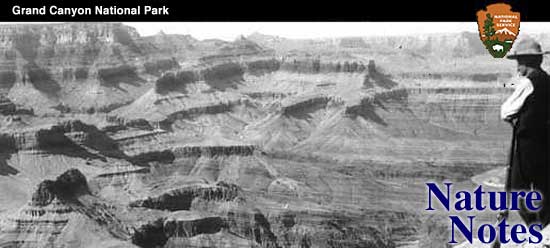

|
By H. H. Waesche, Blacksburg, Virginia. IN the early days, crossing the Grand Canyon was a rather hazardous undertaking. Trails were few in number and poorly defined, and the crossing of the Colorado River was very difficult. Only at a few places was it even possible to get across, and at these places it was necessary for horses to swim behind the boat in going to the opposite side. One of the most accessible places for crossing the river was near the mouth of Bright Angel Creek, at a point where the Kaibab suspension bridge has since been constructed. It was a natural place to cross because of comparatively easy access from both North and South Rims; from the former via Bright Angel Canyon, and from the latter by way of Pipe Creek Canyon. At about the beginning of the present century a small company of Mormons developed a plan to put a cable tram across the Colorado River as an aid in transporting tourists on this portion of their trip from the North Rim to the South Rim of the Grand Canyon. A man by the name of D. Wooley was responsible for the first attempt to put through such a project. He personally advanced five thousand dollars for cable and trail construction, Wooley's son-in-law, Dave Rust, was put in charge of work on both the trail and cable crossing. Some work was done as early as 1903. The cable was taken down as far as the Blue Lime (Redwall) in that year. Rolled into two coils it was transported into the Canyon on the backs of two mules, each carrying one of the coils. It was a difficult process with two mules fastened together, but in spite of this handicap only one mule was killed in the enterprise. Two years were spent, 1905 to 1907, in improving the trail, and finally in 1907 the cable was placed across the river. A small cage, large enough to carry a mule, was suspended from the cable, and by means of other cables could be trammed back and forth above the river.
Coincident with this work, a camp was established near the mouth of Bright Angel Creek, later known as Rust Camp. The Rust party started irrigation and was responsible for the planting of the trees now found in that locality. Rust also did some work on the south side of the river, building a trail from his cable crossing up the inner gorge to the Tonto Plateau. From there he continued it around by way of Burro Spring to the Bright Angel Trail which has been built about 1891 by Cameron Brothers, Pete Berry and others, In 1913 ex-President Theodore Roosevelt made Rust Camp his headquarters while on a hunting expedition in the vicinity. From that time until about 1925 it was called Roosevelt Camp. Since then it has been known as Phantom Ranch, and is now an overnight stopping place for tourists who make trail trips into the Canyon. The name Phantom Ranch is derived from the nearby Phantom Canyon. The ranch is equipped in an up to date manner with a lodge and cabins.
The old cable crossing was used until 1921, when a rather flimsy suspension bridge of the swaying variety took its place. In 1928 the National Park Service constructed a substantial steel suspension bridge near the location of the old one. This bridge is suspended by eight cables, each an inch and a half in diameter, which are anchored to the rock wall on each side of the Inner Gorge. Other cables prevent any horizontal motion. Along with this a much improved trail now extends from the North Rim to the South Rim, with the bridge across the river as its connecting link. The entire unit forms the Kaibab Trail, wonderful both for the scenic beauty it affords and as an engineering feat. | ||||||
| <<< Previous | > Cover < | Next >>> |
vol8-8c.htm
14-Oct-2011